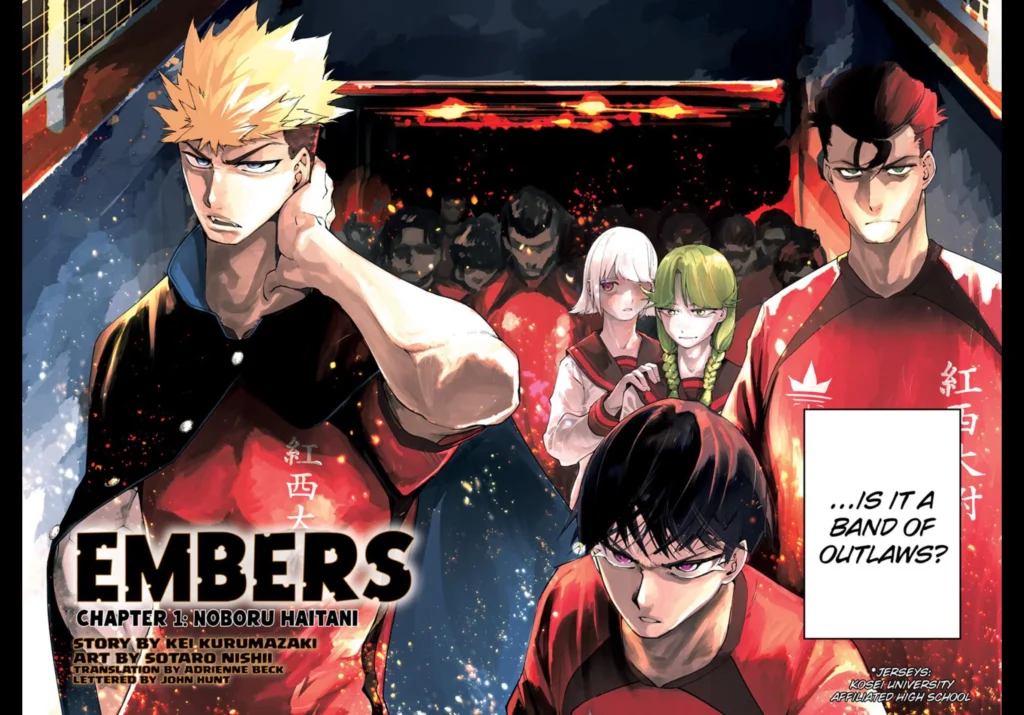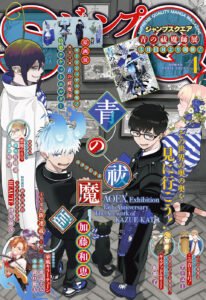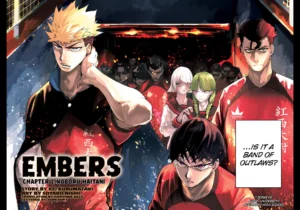
Embers, the newest sports manga in Weekly Shonen Jump, debuted with a bang, grabbing people’s attention. But will that attention be enough to make it a hit? Let’s take a look at the Japanese audience’s reception of the magazine’s latest bet.
The last time Weekly Shonen Jump launched a successful soccer manga was in 1998, the same year Hunter x Hunter debuted. That manga was Whistle!, which lasted a little over four years before being discontinued due to low sales and popularity, especially after an unsuccessful anime adaptation. After that, a few sports manga managed to succeed, with the most recent being Haikyuu!!, which was launched in 2012.
Rival magazines have also struggled in recent years to find a sports manga hit, with Blue Lock (launched in 2017 in Weekly Shonen Magazine) being the last major success in the genre. Naturally, Japanese readers were skeptical about Embers. However, the first chapter managed to trend on Twitter and even got a response from the author of Blue Lock.
Blue Lock artist Yusuke Nomura revealed that Embers’ artist was one of his assistants and stated that “Embers is coming to crush Blue Lock.” The tweet—clearly a promotional move—gained significant attention in Japan, as it came from an author in a rival magazine. This encouraged more people to check out Embers and speculate whether it could surpass Blue Lock (though most believe it won’t). Some even questioned if Embers was already the magazine’s next big hit.
But overall, what did Japanese readers think of Embers?
On Jump Matome (the largest Shonen Jump discussion site) and 5ch (Japan’s biggest manga discussion forum), there were over 500 comments about the manga—a modest number, but one that shows a certain level of interest from readers. A batch of new manga without any veteran authors, followed by a single new series, didn’t help in drawing attention to Embers, but it still generated a decent amount of discussion.
One of the first comments praised the artwork and the bold decision to tackle a soccer manga:
“The art looks much better than what I saw in the trailer. I admire the determination to take on the ‘Path of Shura,’ also known as soccer in Jump, and I’ll be rooting for it!” – Comment from 5ch.
Given the many failed attempts in the past—like Ole Golazo (canceled after 12 chapters) and Tokyo Wonder Boys (canceled after 10 chapters)—some readers expressed admiration for the authors’ decision to invest in a genre that has historically struggled in the magazine. Another aspect that caught the audience’s attention was the emphasis on the protagonist’s “teacher”:
“It was interesting. The fact that the one guiding the protagonist into competition isn’t the heroine or a partner, but a teacher who soon leaves, and on top of that, the teacher isn’t young or handsome, is something new. The only downside is that the rival’s lower white eyelashes make the colored pages look like he has bulging eyes, which is a bit unsettling, but aside from that, it was very good.” – Comment from 5ch.
The teacher’s presence, especially his appearance, was widely praised, as it breaks the usual shonen mold, adding a fresh element to the story. Interestingly, this was mentioned even more than the protagonist’s position as a defender. It’s always noteworthy when unconventional elements are well received, as they hint at unexplored paths that could boost a series’ popularity.
However, not everyone was on board, as some criticized the pacing of the series:
“It was so rushed that I couldn’t connect with anyone,” said a Japanese reader on Twitter.
For those who felt the pacing was too fast, the main criticism was the lack of focus on the protagonist (which indirectly meant they also disliked the teacher’s larger presence).
Continuing with the critiques, some readers were surprised by the seemingly positive reception, as seen in the comments below (from different people):
“This is getting good reviews? The first chapter just felt like a collection of clichés.”
“I feel like the characters ended up shallow because they had to squeeze in the old man’s lesson and the rivalry with the handsome guy.”
“It felt like I was reading a one-shot.”
Clearly, the chapter’s pacing was one of the most criticized aspects. While the artwork and the teacher’s appearance stood out, the lack of focus on the protagonist became a major concern. Other Japanese readers on Jump Matome also commented that the protagonist needs to carry the story more.
Another negative point was the frequent comparisons to Haikyuu!!, as the rivalry between characters felt similar to Tobio and Hinata’s. This comparison appeared across all platforms where comments were tracked—Twitter, Animanch, 5ch, and Jump Matome. Some readers viewed this similarity negatively, while others were more neutral.
Ending on a positive note, most readers enjoyed the match, particularly praising the protagonist’s artwork. He had strong visual impact in several pages, and the reading experience was considered smooth. The well-executed cliffhangers, proper use of vertical layouts in emotional moments, and dynamic paneling at the right times made the story enjoyable for many—an essential factor for a manga’s survival.
It is undeniable that the artist has delivered a work that visually appeals to readers. However, improvements are needed in the storytelling aspect. I believe that, for the manga to survive, the first step MUST be to further develop the protagonist. Japanese readers like delinquent heroes, but as they themselves have pointed out, they have already seen this in Slam Dunk. They need to get to know him better for the story to hold up—he needs to stand out and become more unique.
“A clichéd story is not a problem, but in this case, the characters, especially the protagonist, need to be captivating. Something like Sakuragi’s absurd strength and foolishness or Hinata’s incredibly strong mentality in Haikyuu!!. I want that feeling of ‘this guy is not just any protagonist,’ something that makes him unique.” – A comment from Jump Matome.
Embers had a strong start, with promotion from the Blue Lock author, trending on Twitter, praise for its paneling, and the professor drawing attention. However, the lack of focus on the protagonist and the fast pacing of the chapter disappointed some readers, which could become a problem if the author fails to properly develop both the protagonist and the supporting characters.
Embers started well but needs to address these issues in the second chapter to survive in Japan’s most competitive magazine. Some people, due to the Blue Lock tweet, have already labeled it as the “New Hit,” but in reality, it still needs more to secure its place in the magazine. If the criticized points are improved, it could indeed become a new hit.
Keep in mind that these comments reflect the opinions of internet users, which may differ from the more casual audience that reads the magazine but does not comment. All the comments collected were from Japanese readers, not Western ones. When the third chapter is released, I will bring more updates on the reception of Embers. Stay tuned!






